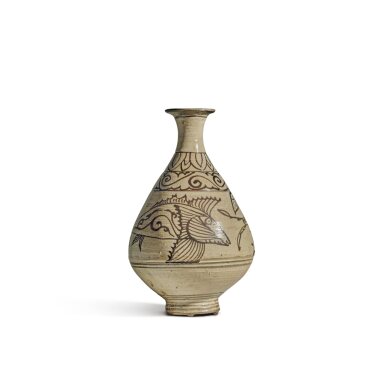SUBLIME BEAUTY: Korean Ceramics from a Private Collection
SUBLIME BEAUTY: Korean Ceramics from a Private Collection

A painted Buncheong 'fish' pear-shaped vase, Joseon dynasty, 15th / 16th century
Lot Closed
September 22, 02:23 PM GMT
Estimate
100,000 - 150,000 USD
Lot Details
Description
A painted Buncheong 'fish' pear-shaped vase
Joseon dynasty, 15th / 16th century
Japanese wood box (3)
Height 11⅛ in., 28.2 cm
Charmingly painted, the fish on the present vase drift through an aquatic landscape of stylized waterweed, with large ridged fins and arabesques on their bodies. Fish have had long symbolic associations in East Asia, connoting happiness, fertility, abundance, and even conjuring up the famous passage in Zhuangzi (late 4th century BC) where Zhuangzi and his companion Huizi debate the happiness of fish and the limits of human knowledge. Furthermore, fish is a staple of the Korean diet, and as Soyoung Lee and Jeon Seung-chang note, the wit in employing this motif on food and beverage vessels would not have been lost on viewers (‘Decoding Design: Buncheong's Forms, Decorative Techniques, and Motifs’, Korean Buncheong Ceramics from Leeum, Samsung Museum of Art, New York, 2011, p. 68).
Buncheong wares decorated with iron-oxide pigment was produced almost exclusively at the kilns of the Gyeryongsan Mountains at Hakbong-ri, Gongju, Chungcheong Province, and were among the last of the buncheong produced at this site. As such, they are often called ‘Gyeryongsan buncheong’. The shape and decorative technique of the present vase resemble Cizhou painted wares from Yuan dynasty China. Although there is no direct connection between Cizhou and buncheong ware, and it is possible that such techniques and motifs were independently devised during the Joseon period, Cizhou ceramics were exported to Korea in large quantities around the 14th century, as exemplified by finds from the famous Sinan shipwreck.
For a closely related vase, painted with stylistically similar fish but lacking the two registers of decoration above, compare one in the collection of Leeum, Samsung Museum of Art, Seoul, illustrated in ibid., cat. no. 39. Another vase, with more exaggerated fish scales, was formerly in the collection of Avery Brundage and is now in the Asian Art Museum, San Francisco (accession no. B65P63). A further vase with more stylized and abbreviated painting is in the British Museum, London (accession no. 2000,1130.1). See two others sold at Christie's New York: the first, 18th September 2000, lot 370, and the second, 14th April 2016, lot 99.
